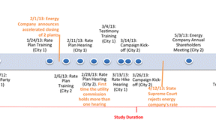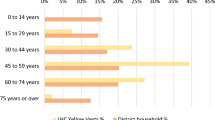Abstract
What happens at convenings held by community-based civil society organizations and how do they influence organizational outcomes? Although ethnographies provide details about organizations’ internal dynamics, they offer limited insights into the distribution of those dynamics and their impact on outcomes. This article describes systematic social observation and explains how we adapted this method to CSOs for collecting data on multiple convenings from several organizations. To demonstrate the method’s viability, we digitized our SSO tool and used it in a pilot study of three CSOs in Indianapolis to collect observational data from 99 convenings. We illustrate the value of SSO for studying CSOs by presenting distributions of interaction styles and cross-demographic interaction across organizations. We note how such data could be combined with survey and administrative data to analyze the impact of CSOs internal dynamics on organizational outcomes. We conclude by discussing the broader utility and limitations of the SSO method for research on CSOs and the third sector.



Similar content being viewed by others
Notes
Apart from participants who verbally self-identify during a convening, observers generally do not acquire participants’ self-reported demographic identities. Instead, the observers capture “street race” (López et al., 2018) and “sex category” (West & Zimmerman, 1987)—categories individuals are placed in by outside observers.
We attempted to observe every convening held by each organization during the study period. Although organizations occasionally requested that we not observe certain convenings and scheduling challenges prevented us from observing others, our study captured data from most convenings held by each organization. The number of observed convenings varies across organizations based primarily on the number of convenings the organizations held.
While SSO tools are rarely changed during a single study, they can be changed between studies to address different theoretical points of interest––broadening the tool’s applicability.
References
Albareda, A. (2018). Connecting society and policymakers? Conceptualizing and measuring the capacity of civil society organizations to act as transmission belts. VOLUNTAS: International Journal of Voluntary and Nonprofit Organizations, 29(6), 1216–1232.
Baggetta, M. (2009). Civic opportunities in associations: Interpersonal interaction, governance experience and institutional relationships. Social Forces, 88(1), 175–199.
Baggetta, M., & Bredenkamp, D. M. (2019). Systematic social observation in the study of civil society organizations. Sociological Methods & Research. https://doi.org/10.1177/0049124119826148
Bail, C. A. (2012). The fringe effect: Civil society organizations and the evolution of media discourse about Islam since the September 11th attacks. American Sociological Review, 77(6), 855–879.
Baiocchi, G., Bennett, E. A., Cordner, A., Klein, P. T., & Savell, S. (2013). The civic imagination: Making a difference in American political life. Paradigm Publishers.
Barakso, M. (2004). Governing NOW: Grassroots activism in the national organization for women. Cornell University Press.
Blee, K. M. (2012). Democracy in the making: How activist groups form. Oxford University Press.
Braunstein, R., Fulton, B. R., & Wood, R. L. (2014). The role of bridging cultural practices in racially and socioeconomically diverse civic organizations. American Sociological Review, 79(4), 705–725.
Chaves, M. (2004). Congregations in america. Harvard University Press.
Coffé, H., & Geys, B. (2007). Toward an empirical characterization of bridging and bonding social capital. Nonprofit and Voluntary Sector Quarterly, 36(1), 121–139.
Doussard, M., & Fulton, B. R. (2020). Organizing together: Benefits and drawbacks of community-labor coalitions for community organizing. Social Service Review, 94(1), 36–74.
Earl, J., Martin, A., McCarthy, J. D., & Soule, S. (2004). The use of newspaper data in the study of collective action. Annual Review of Sociology, 30, 65–80.
Edwards, M. (2014). Civil society. Polity Press.
Eliasoph, N. (1998). Avoiding politics: How Americans produce apathy in everyday life. Cambridge University Press.
Eliasoph, N. (2009). Top-down civic projects are not grassroots associations: How the differences matter in everyday life. VOLUNTAS: International Journal of Voluntary and Nonprofit Organizations, 20(3), 291–308.
Eliasoph, N., & Lichterman, P. (2003). Culture in interaction. American Journal of Sociology, 108(4), 735–794.
Fine, G. A. (2012). Tiny publics: A theory of group action and culture. Russell Sage Foundation.
Firat, R. B., & Glanville, J. L. (2017). Measuring diversity in voluntary association membership. Nonprofit and Voluntary Sector Quarterly, 46(1), 218–230.
Fisher, D. R., Stanley, K., Berman, D., & Neff, G. (2005). How do organizations matter?: Mobilization and support for participants at five globalization protests. Social Problems, 52, 102–121.
Fulton, B. R. (2021a). Bridging and bonding: Disentangling two mechanisms underlying the diversity-performance relationship. Nonprofit and Voluntary Sector Quarterly, 50(1), 54–76.
Fulton, B. R. (2021b). Engaging differences: How socially diverse organizations can mobilize their resources more effectively. Social Forces, 99(4), 1518–1546.
Fulton, B. R., Oyakawa, M., & Wood, R. L. (2019). Critical standpoint: Leaders of color advancing racial equality in predominantly white organizations. Nonprofit Management & Leadership, 30(2), 255–276.
Fulton, B. R., & Wood, R. L. (2018). Civil society organizations and the enduring role of religion in promoting democratic engagement. VOLUNTAS: International Journal of Voluntary and Nonprofit Organizations, 29(5), 1068–1079.
Gaby, S., & Caren, N. (2012). Occupy online: How cute old men and Malcolm X recruited 400,000 US users to OWS on Facebook. Social Movement Studies, 11(3–4), 367–374.
Grubb, A., & Henriksen, L. S. (2019). On the changing civic landscape in Denmark and its consequences for civic action. VOLUNTAS: International Journal of Voluntary and Nonprofit Organizations, 30(1), 62–73.
Kaufman, J., & Tepper, S. J. (1999). Groups or gatherings? Sources of political engagement in 19th century American cities. VOLUNTAS: International Journal of Voluntary and Nonprofit Organizations, 10(4), 299–322.
Lamont, M., & Molnár, V. (2002). The study of boundaries in the social sciences. Annual Review of Sociology, 28(1), 167–195.
Larrick, R. P. (2016). The social context of decisions. Annual Review of Organizational Psychology and Organizational Behavior, 3, 441–467.
Lee, J. J., & McCabe, J. M. (2021). Who speaks and who listens: Revisiting the chilly climate in college classrooms. Gender and Society, 35(1), 32–60.
Lei, Z., & Lehmann-Willenbrock, N. (2015). Dynamic affect in team meetings: An interpersonal construct embedded in dynamic interaction processes. In J. A. Allen, N. Lehmann-Willenbrock, & S. G. Rogelberg (Eds.), Cambridge Handbook of Meeting Science (pp. 456–80). New York, NY: Cambridge University Press.
López, N., Vargas, E., Juarez, M., Cacari-Stone, L., & Bettez, S. (2018). What’s your “street race”? Leveraging multidimensional measures of race and intersectionality for examining physical and mental health status among Latinxs. Sociology of Race and Ethnicity, 4, 49–66.
Mathews, M. A. (2020). The embeddedness of nonprofit leadership in civic governance. VOLUNTAS: International Journal of Voluntary and Nonprofit Organizations, 31(1), 201–212.
McCall, G. J. (1984). Systematic field observation. Annual Review of Sociology, 10(1), 263–282.
Nippert-Eng, C. (2015). Watching closely: A guide to ethnographic observation. Oxford University Press.
Oyakawa, M., McKenna, E., & Han, H. (2020). Habits of courage: Reconceptualizing risk in social movement organizing. Journal of Community Psychology. https://doi.org/10.1002/jcop.22355.
Paxton, P. (2002). Social capital and democracy: An interdependent relationship. American Sociological Review, 67(2), 254–277.
Putnam, R. (2000). Bowling alone: The collapse and revival of American community. NY: Simon and Schuster.
Reiss, A. J. (1971). The police and the public. Yale University Press.
Rogelberg, S. G. (2019). Why your meetings stink-and what to do about it. Harvard Business Review, pp. 140–143.
Sampson, R. J. (2012). Great American city: Chicago and the enduring neighborhood effect. University of Chicago Press.
Sampson, R. J., McAdam, D., MacIndoe, H., & Weffer-Elizondo, S. (2005). Civil society reconsidered: The durable nature and community structure of collective civic action. American Journal of Sociology, 111(3), 673–714.
Schnable, A. (2021). Amateurs without borders: The aspirations and limits of global compassion. University of California Press.
Skocpol, T. (2003). Diminished democracy: From membership to management in American civic life. University of Oklahoma Press.
Small, M., & Adler, L. (2019). The role of space in the formation of social ties. Annual Review of Sociology, 45, 111–132.
Stone, M. M. (1996). Competing contexts: The evolution of a nonprofit organization’s governance system in multiple environments. Administration & Society, 28(1), 61–89.
Tocqueville, A. (2000 [1835]). Democracy in America. University of Chicago Press.
Underhill, P. (1999). Why we buy: The science of shopping. Simon & Schuster.
Verba, S., Schlozman, K. L., & Brady, H. E. (1995). Voice and equality: Civic voluntarism in American politics. Harvard University Press.
Weare, C., Musso, J., & Jun, K.-N. (2009). Cross-talk: The role of homophily and elite bias in civic associations. Social Forces, 88(1), 147–173.
Weick, K. E. (1968). Systematic observational methods. In G. Lindzey & E. Aronson (Eds.), Handbook of social psychology (pp. 357–451). Addison-Wesley.
West, C., & Zimmerman, D. H. (1987). Doing Gender. Gender and Society, 1(2), 125–151.
Whyte, W. H. (1980). The social life of small urban spaces. Project for Public Spaces.
Wood, R. L., & Fulton, B. R. (2015). A shared future: Faith-based organizing for racial equity and ethical democracy. University of Chicago Press.
Woolcock, M. (2011). Civil society and social capital. In M. Edwards (Ed.), Oxford handbook of civil society (pp. 197–208). Oxford University Press.
Yukich, G., Fulton, B. R., & Wood, R. L. (2020). Representative group styles: How ally immigrant rights organizations promote immigrant involvement. Social Problems, 67, 488–506.
Acknowledgements
The authors thank Zoe Caplan, Estela Lopez, Marisela Sanchez, Sean Baird, Stacia Murphy, Renzo de la Riva Aguero, Benjamim Eduardo, Josette Robinson, and Bethany Van Alstine for collecting data in the field and providing feedback on the tool; Zoe Caplan, Renzo de la Riva Aguero, Shengnan Yang, and Derek Richardson for research team management and data analysis work; Emma Frankham for editorial assistance; the Corporation for National and Community Service, especially Andrea Robles, Roshni Menon, Melissa Gouge, and Kimberly Hammonds, for guidance with the grant process; the O’Neill School Business Office, especially Allison Howell, Taylor Ritchie, and Penny Volrich, for human resources support and grant management; and, most of all, the leaders, staff, and members of the three community-based organizations for their participation in the study.
Funding
This work was supported by the Corporation for National and Community Service, Office of Research and Evaluation [17RE197141], and by Indiana University’s Social Sciences Research Funding Program.
Author information
Authors and Affiliations
Corresponding author
Additional information
Publisher's Note
Springer Nature remains neutral with regard to jurisdictional claims in published maps and institutional affiliations.
Rights and permissions
About this article
Cite this article
Fulton, B.R., Baggetta, M. Observing Civic Engagement: Using Systematic Social Observation to Study Civil Society Organization Convenings. Voluntas 33, 1187–1195 (2022). https://doi.org/10.1007/s11266-021-00418-7
Accepted:
Published:
Issue Date:
DOI: https://doi.org/10.1007/s11266-021-00418-7




